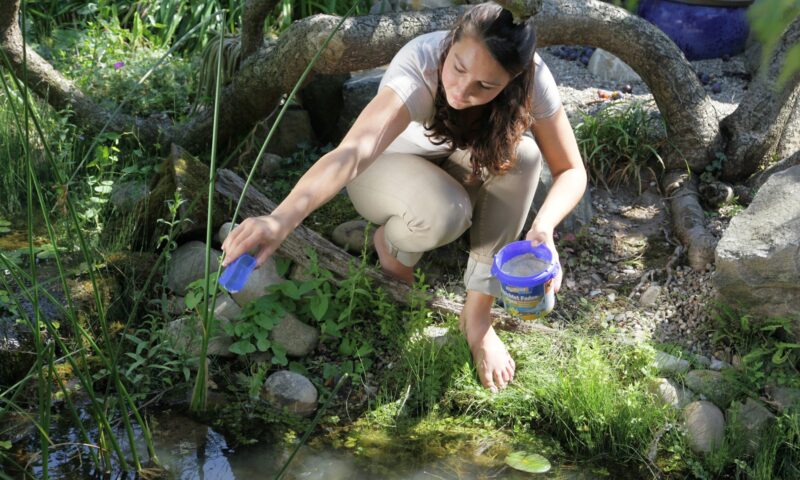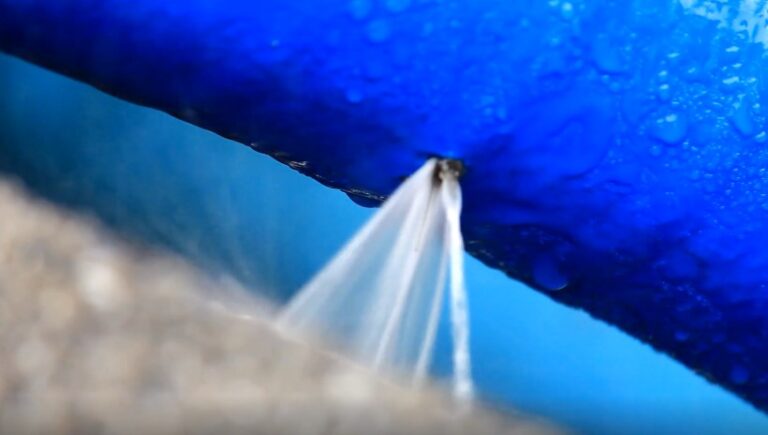Maintaining a pond throughout the year helps create a balanced and healthy ecosystem. Each season presents specific challenges, requiring consistent care and attention.
Shifts in weather, water quality, and aquatic life all contribute to the maintenance demands that arise with seasonal changes.
Establishing a regular care routine keeps fish and plants thriving while maintaining overall water quality.
Spring Pond Care – Awakening After Winter
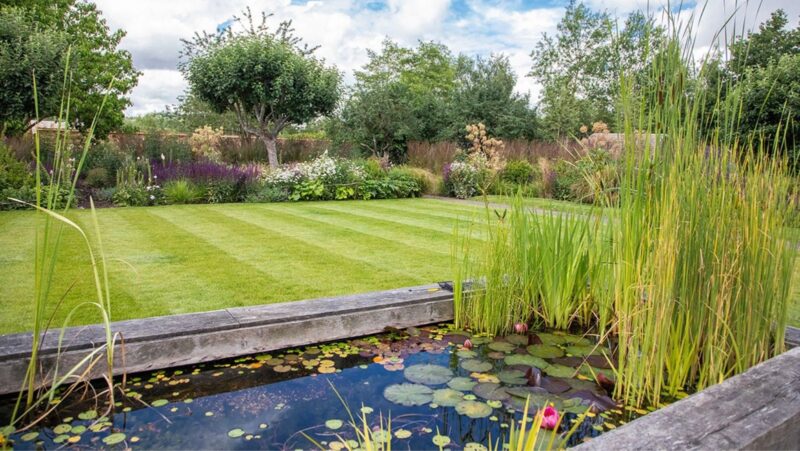
Spring signals the end of cold weather and the start of renewed growth in the pond. Ice begins to melt, plants emerge from dormancy, and fish activity increases.
Proper spring maintenance sets the foundation for a thriving pond ecosystem through the warmer months.
Addressing debris, water quality, and aquatic life helps create a stable and healthy environment.
Spring Cleaning
As temperatures rise and ice melts, ponds begin to thaw, revealing accumulated debris and sludge that may have settled at the bottom.
Stagnant water and organic waste can create toxic conditions for fish and plants if left untreated.
A thorough cleaning process helps reset the pond’s ecosystem and promotes healthy growth.
- Remove debris and sludge – Organic material, such as leaves, twigs, and decaying plants, contributes to increased ammonia and nitrate levels, which can harm aquatic life.
- Clean and reinstall equipment – Pumps, filters, and UV clarifiers that were removed during winter storage need to be inspected and cleaned before reinstallation.
- Inspect pond liners and edges – Freezing and thawing cycles can cause pond liners to crack or shift.
- Remove algae buildup – Spring warmth encourages early algae growth. Use a brush or algae scraper to clean pond walls and rocks.
- Rinse and refresh water – Once debris and sludge have been removed, add fresh dechlorinated water to maintain proper levels.
Reintroducing Fish and Plants
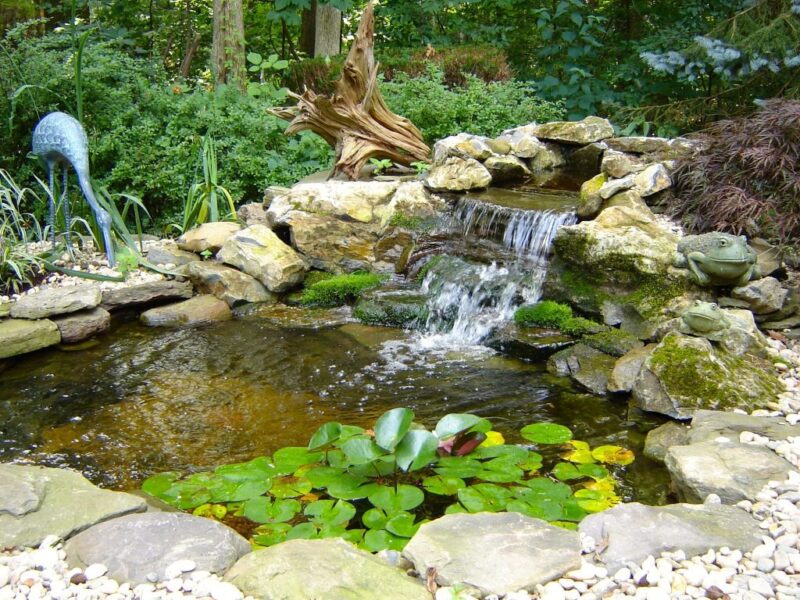
Gradually reintroducing fish and plants ensures that aquatic life adjusts to changing water conditions without stress or shock.
Sudden changes in temperature or water chemistry can disrupt fish metabolism and plant growth.
- Acclimate fish slowly – Float the transport bag containing fish in the pond for 15–20 minutes.
- Trim away dead plant material – Remove any brown or decaying leaves and stems from aquatic plants.
- Introduce hardy aquatic plants – Early spring is an ideal time to add new oxygenating plants such as hornwort, water lilies, or anacharis.
- Watch for signs of stress – After introducing fish and plants, monitor behavior and growth. Lethargy, gasping at the surface, or discoloration can indicate issues with water quality or acclimation.
Water Quality Testing and Equipment Checks
Maintaining proper water quality supports a balanced ecosystem and helps prevent issues like fish disease and algae blooms.
Testing regularly and adjusting treatments as needed keeps water parameters stable.
- Test for pH, ammonia, nitrate, and nitrite levels – Use a pond test kit to monitor chemical levels weekly. pH should range between 6.5 and 8.0, with ammonia and nitrate levels close to zero.
- Check equipment performance – Pumps and filters need to run consistently to maintain water circulation and filtration.
- Adjust water treatments – Use pond-safe conditioners to neutralize chlorine and chloramines in tap water.
- Ensure proper aeration – Lack of oxygen can cause fish to suffocate and promote algae growth.
- Monitor water clarity – Cloudy or green water indicates excess nutrients or poor filtration.
A successful spring pond care routine creates the foundation for a vibrant and healthy pond throughout the year.
Use a pond heater or de-icer to keep a small opening in the ice for proper ventilation. Products like this Ice-Out solution can help prevent freezing and maintain a healthy environment for fish and plants.
Summer Pond Care – Battling Heat and Algae
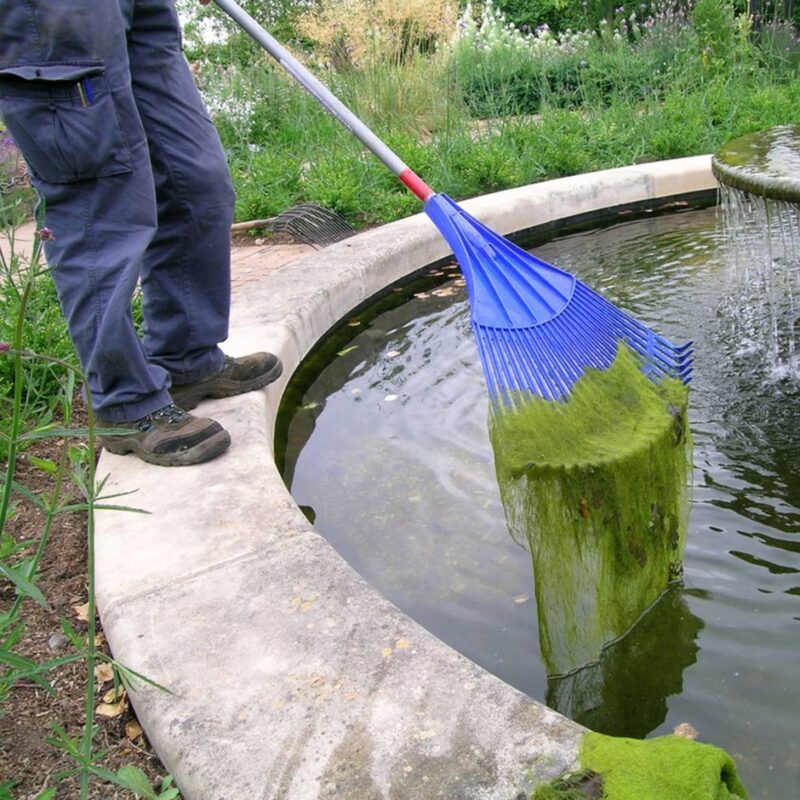
Summer presents some of the most challenging conditions for pond maintenance. Increased sunlight and rising temperatures create an ideal environment for algae growth and oxygen depletion, which can lead to unhealthy water conditions and stressed aquatic life.
Adjusting care routines to meet seasonal demands helps maintain a healthy ecosystem.
Algae Control
Algae blooms become more aggressive in summer due to intense sunlight and warm water.
Excessive algae growth reduces oxygen levels, suffocates aquatic plants, and creates an unattractive greenish tint in the water.
Managing algae is essential for preserving water clarity and overall pond health.
- Install UV clarifiers to help control algae populations by targeting single-cell algae and reducing their ability to multiply. UV clarifiers use ultraviolet light to damage algae cells, preventing them from forming large blooms.
- Add oxygenating plants like anacharis, hornwort, and water hyacinths to absorb excess nutrients that feed algae growth. These plants compete with algae for resources, reducing their ability to thrive.
- Skim the pond surface regularly to remove floating algae and debris before they sink and contribute to nutrient buildup.
- Adjust feeding practices to prevent overfeeding, which introduces additional nutrients that fuel algae growth.
Oxygenation and Temperature Management
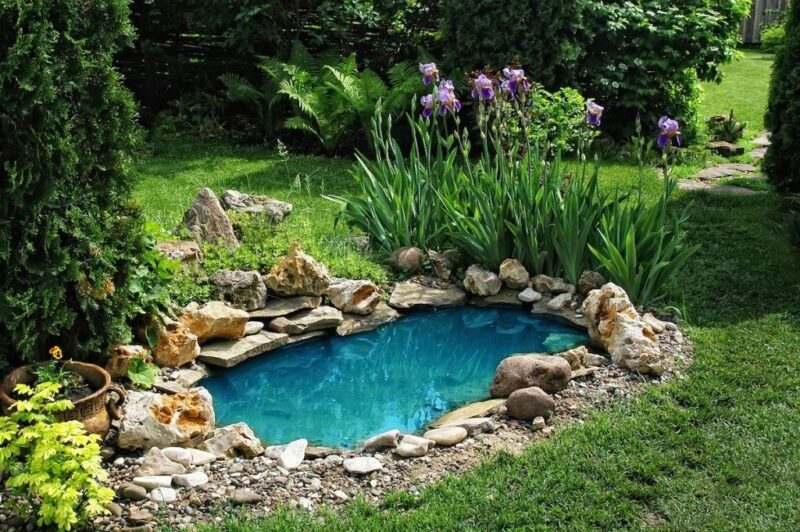
High temperatures reduce the capacity of water to hold oxygen, which can create stressful conditions for fish and aquatic plants. Reduced oxygen levels make fish more susceptible to disease and inhibit plant growth. Ensuring proper oxygenation and temperature regulation prevents these issues.
Install fountains, waterfalls, or aerators to increase water circulation and oxygen levels. Moving water allows for better gas exchange and helps maintain higher oxygen concentrations.
Provide shade using water lilies, lotus plants, or floating plants. Shade reduces the intensity of sunlight, helping to prevent overheating and excessive algae growth.
Consider installing a pond chiller for extreme heat conditions. Chillers work by circulating water through a cooling system, helping to keep temperatures within a safe range for fish and plants.
Maintain an open water surface to facilitate oxygen exchange. Remove any overgrown plants or debris that could block airflow at the surface.
Monitor fish for signs of oxygen depletion, such as gasping at the surface or sluggish behavior, and adjust oxygenation levels as needed.
Water Level Maintenance
Evaporation increases during summer, causing water levels to drop rapidly. Lower water levels lead to increased concentrations of harmful substances and disrupt the pond’s ecological balance.
Maintaining consistent water levels reduces stress on aquatic life.
- Top up the pond with dechlorinated water to replace lost volume. Chlorine and chloramine in tap water can harm fish, so treating water before adding it helps prevent toxicity issues.
- Monitor for leaks or cracks in the pond liner. Increased evaporation rates and soil shifting caused by high temperatures can lead to minor cracks and water loss. Repair any damage promptly.
- Avoid overfilling the pond, as sudden changes in water levels can stress fish and disrupt the natural balance of the ecosystem.
- Add a water-level sensor or automatic refill system to maintain consistent levels without overfilling.
Consider installing a small overflow outlet to prevent flooding during summer storms while maintaining proper water balance.
Autumn Pond Care – Preparing for the Cold
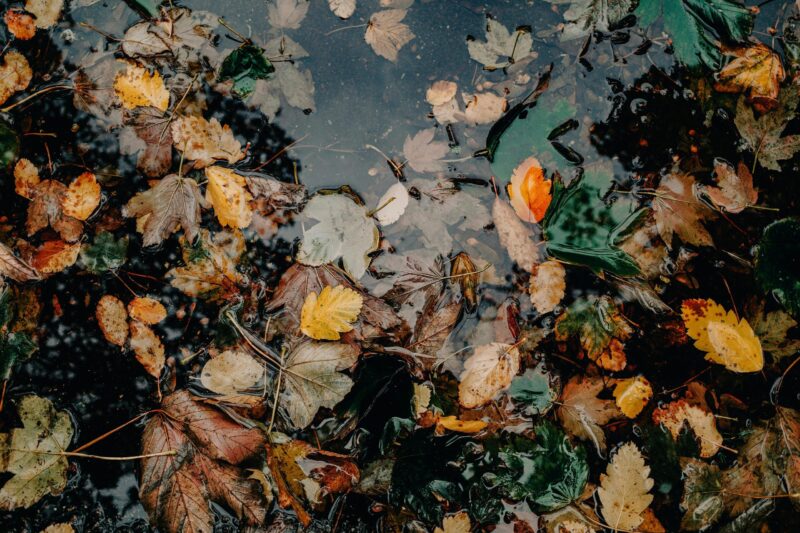
Seasonal changes bring a drop in temperature and increased debris, making autumn an important time for pond maintenance. Leaves, organic matter, and overgrown plants can quickly affect:
- Water quality
- Oxygen levels
Taking the right steps in autumn helps prepare the pond for winter dormancy and protects aquatic life.
Leaf Removal and Debris Management
Leaves and organic debris start falling as temperatures cool, and if left unchecked, they break down and release harmful compounds into the water.
Decomposing leaves and plant material increase ammonia and nitrate levels, which can harm fish and disrupt the pond’s ecosystem. Keeping the pond surface and bottom clean prevents long-term damage.
Install pond netting over the surface to catch falling leaves before they reach the water. This helps reduce the amount of debris that settles at the bottom and minimizes cleanup efforts later.
Skim the pond surface daily to remove floating debris, including leaves, twigs, and insects. A long-handled skimmer makes it easier to reach the center of the pond.
Use a pond vacuum or net to remove submerged debris. Organic matter that sinks to the bottom can create oxygen-depleting sludge and harmful gas buildup.
Check the pond’s filtration system for blockages caused by increased debris. Clean the filter regularly to maintain proper water circulation and clarity.
Remove any dead or decaying plant material around the edges of the pond to prevent it from entering the water.
Reducing Feeding and Fish Preparation
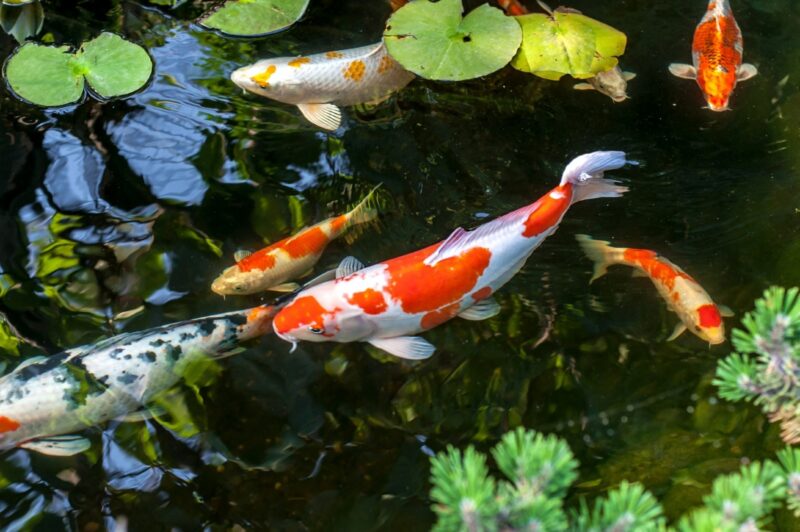
As temperatures fall, fish become less active, and their metabolism slows down.
Feeding patterns need to change to prevent overfeeding, which can lead to uneaten food decaying in the water and causing water quality issues.
Fish also need to build up reserves for winter when feeding stops altogether.
- Gradually reduce feeding when water temperatures drop below 50°F. Fish digestion slows at lower temperatures, and excessive feeding can lead to digestive issues and poor water quality.
- Provide high-fat food in early autumn to help fish build fat reserves that will sustain them through winter dormancy. Coldwater fish, such as koi and goldfish, benefit from extra nutrients during this time.
- Monitor fish behavior for signs of stress, such as sluggishness, lack of appetite, or discoloration. Any signs of illness should be addressed before winter sets in since colder temperatures can worsen health issues.
- Adjust feeding frequency based on temperature changes. Feed less often as temperatures decline, and stop feeding completely once the pond water drops below 40°F.
Ensure that fish have access to a quiet, sheltered area within the pond where they can remain undisturbed through winter dormancy.
Trimming and Equipment Storage
Cutting back overgrown plants and properly storing equipment protects the pond environment and reduces maintenance challenges in winter.
Overgrown plants can contribute to nutrient imbalances, while delicate equipment left in freezing conditions may suffer damage.
- Trim back overgrown aquatic plants, such as water lilies and reeds, to prevent nutrient buildup in the water. Cut stems down to a few inches above the waterline to avoid decay during winter.
- Remove non-hardy plants, including tropical varieties, and store them in a sheltered area until spring. Hardy plants, such as water iris and pickerelweed, can remain in the pond.
- Disconnect and store pumps, filters, and UV clarifiers that are not rated for freezing temperatures. Freezing water can crack or damage equipment, leading to costly repairs or replacements.
Winter Pond Care – Protecting Through the Cold
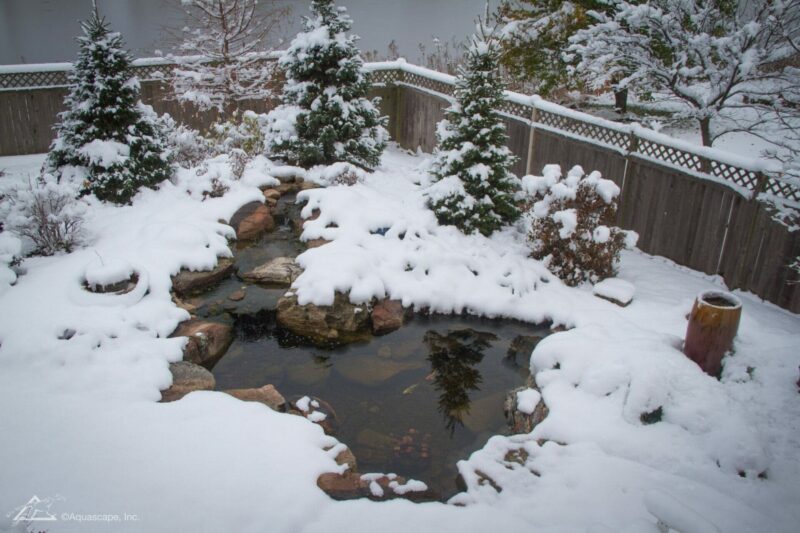
Cold weather creates harsh conditions for ponds, making proper winter care essential for the survival of aquatic life. Fish and plants become vulnerable to freezing temperatures, ice buildup, and reduced oxygen levels.
Careful monitoring and adjustments help prevent these issues and support a healthy pond environment throughout winter. A
Adjusting feeding habits, protecting equipment, and minimizing disturbance are key to ensuring fish and plants survive the season.
Prevent Freezing
Freezing temperatures pose significant threats to pond health by cutting off essential gas exchange and reducing oxygen levels. Ice buildup also creates pressure, which can damage equipment and stress aquatic life.
- Use a pond heater or de-icer to create a small opening in the ice. Even a small opening can significantly improve pond health.
- Position an aerator near the surface to keep water moving and prevent the formation of a solid ice layer. Aeration increases oxygen levels and reduces the risk of complete freezing.
- Avoid breaking ice with sharp objects. Sudden vibrations or pressure changes can shock or injure fish. Let natural thawing or de-icers handle the ice to avoid stressing aquatic life.
- Use a floating thermometer to monitor water temperature and adjust heating equipment as needed. Keeping water temperatures stable helps prevent sudden temperature shifts that can harm fish and plants.
Minimal Disturbance
Ponds enter a state of dormancy during winter. Excessive disturbance can interfere with this natural cycle and cause stress to fish and plants.
- Avoid walking on the ice, as vibrations and pressure can disturb the pond floor and stress fish. Ice can also crack under pressure, which could injure aquatic life.
- Keep noise levels low near the pond. Sudden loud sounds or vibrations can disrupt fish and other aquatic organisms.
- Remove snow accumulation from the pond’s surface. A layer of snow blocks sunlight, which prevents photosynthesis and reduces oxygen production.
Check for signs of freezing or gas buildup without physically disturbing the pond. Observing the behavior of fish and the condition of the water surface provides clues about the pond’s health.
The Bottom Line
Consistent seasonal pond care supports a balanced and healthy ecosystem.
Proper maintenance through cleaning, feeding adjustments, water quality testing, and seasonal preparation ensures fish and plants thrive year-round.
Establishing a structured care routine helps prevent problems and keeps the pond in optimal condition through all weather conditions.
Related Posts:
- Essential Pond Maintenance Tips for a Healthy Ecosystem
- How To Care for Your Face Skin ─ A Beginner’s Guide…
- What are the 5 Keys to UPS System Maintenance
- Essential Tips for Physicians to Manage Medical…
- How Do I Prolong My SD Card Life? Essential Tips and Tricks
- 20 Essential Skills You Need to Become a Machine…

